We did not take a summer vacation in 2019 because, well, life. So when I discovered that both my college freshman and my college senior would be home for winter break by December 14th, I knew that was our vacation window.
But a vacation in December is tough if you (a) don’t want to go to the beach and (b) do not ski. I googled “where to vacation in December” out of desperation, and up came my answer. The national park (we love national parks) that is unbearably hot during the summer is lovely during the winter months. Bingo! We’re heading to Death Valley, and staying in the little town of Furnace Creek.
I’m surprised to find that the nearest airport to Death Valley, California is the Las Vegas airport, which is about two hours away. I know we don’t need a week in Death Valley, so we decide to add a day and a half in Sin City to the end of our trip. We end up being away for six nights – four in Death Valley and two in Vegas. It’s perfect, and gets us home before the brunt of holiday travel.
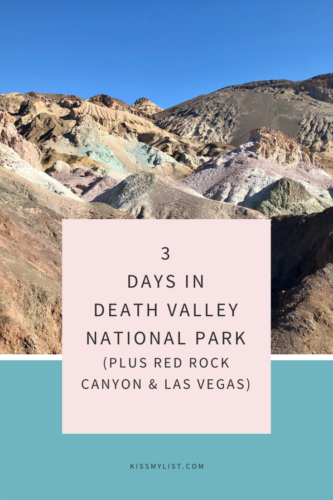
We arrive in Las Vegas in early afternoon, pick up our rental car, and get lunch at In-N-Out Burger. It’s the first visit for these East Coasters, and we get what all the fuss is about. When we arrive at our hotel, it’s pitch black except for the brilliant starry sky; we are truly in the middle of the desert.
A little background: Death Valley is located in southeastern California, and it is the largest national park in the 48 states, covering over three million acres. The hottest temperature ever recorded in the world was in 1913, in Furnace Creek, Death Valley. That temperature was 134 degrees Fahrenheit, which is why visiting in December is so appealing.
Day One in Death Valley
Our first day itinerary hitS all the “must-see” spots in Death Valley for visitors just there for the day. Our hotel Is less than twenty minutes from our first stop, and we arrive just before 9:00 a.m.
Badwater Basin
Badwater Basin is the lowest point in North America, at 282 feet below sea level. This is difficult to fathom without a visual aid, so allow me to scribble on a photo:
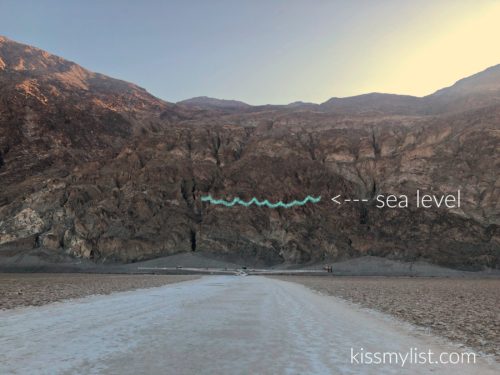
Thousands of years ago, the basin contained a lake, which evaporated and left a layer of salt. My daughter is the first of us to confirm that yes, the white stuff that looks like a light dusting of snow is actually salt.
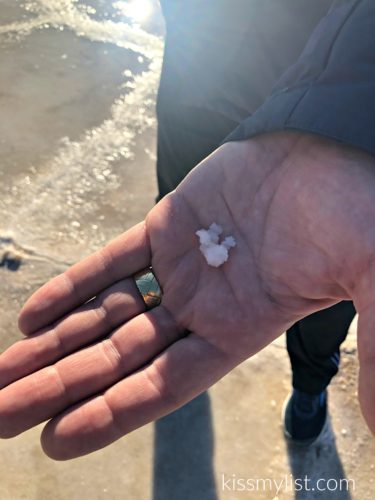
Later, Google informs us the water at Badwater Basin is three times saltier than the ocean. But where is the water?
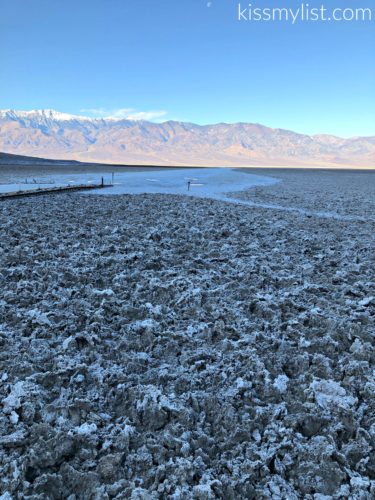
We reach the point where the briny pond would be – all that is left of the lake. It’s nonexistent in the summer, and I imagine the whole area looks like this.
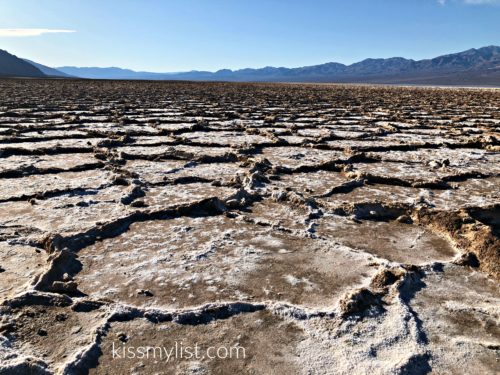
We’ve walked one mile from the parking lot before our feet skim a few millimeters of water. I’d hardly call this a pond, but in Death Valley it’s an oasis.
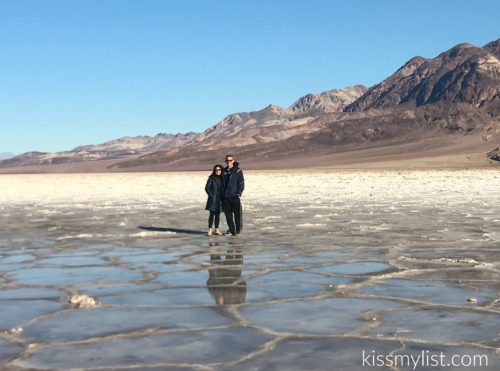
We can see for what seems like miles, and the mountains that feel so close are in reality so far away. I take this shot of my kids without the zoom but even this doesn’t convey the vastness of the landscape.
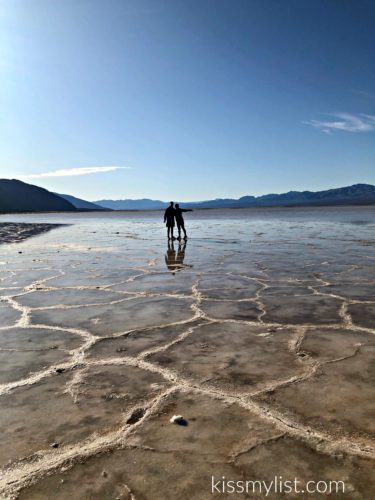
Natural Bridge
After a ten minute car ride, we arrive at the trailhead for the Natural Bridge. We hike a mere quarter mile, although it is all uphill and decidedly unenjoyable. We are rewarded with this natural bridge, which looks more like a huge doorway to me.
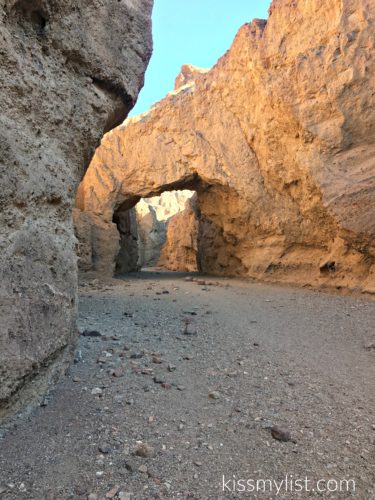
A bit past the bridge the trail ends at this dry waterfall. The boys keep going for a few minutes but then decide it’s not worth it and we head back downhill.
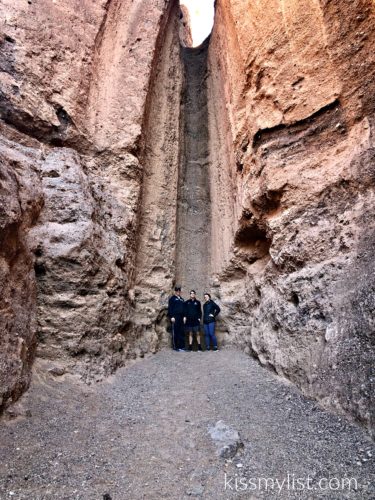
Devil’s Golf Course
Another few minutes back in the car brings us to Devil’s Golf Course, so named because Death Valley’s salt crusted floor looks like a warped coral reef.
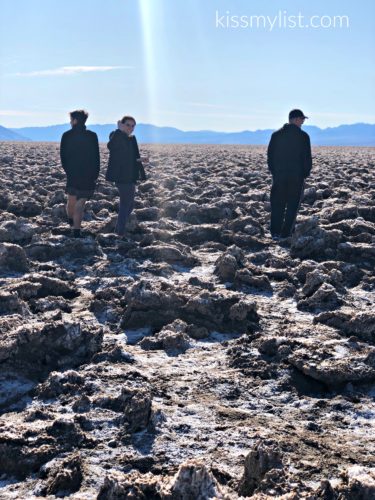
All the lumps and bumps are from that evaporated lake, and we gingerly walk out a few feet to examine the salty terrain close up.
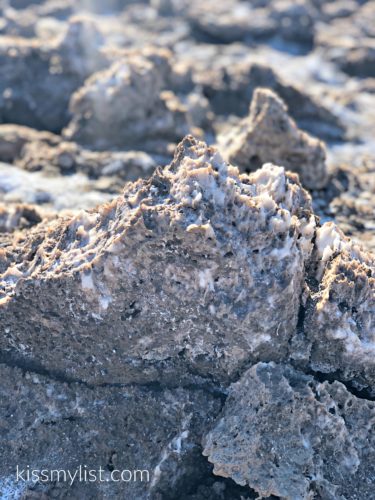
The tips are sharp, and you couldn’t pay me enough money to walk out there barefooted. I don’t venture far even with athletic shoes; I’m not known for my balance and grace.
Artist’s Palette
Next we drive the nine mile loop of Artist’s Drive, with all its dips and curves through ravines and walls of rock. We pull off to climb the rocks at Artist’s Palette, which look like they’ve been dusted with chalk.
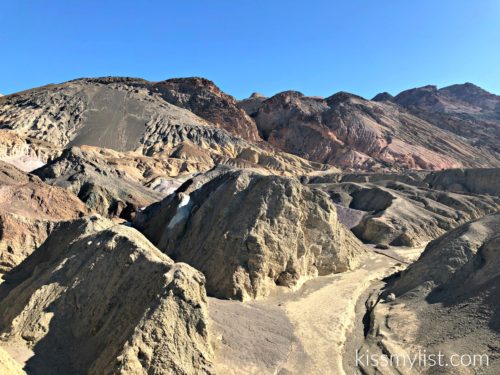
The colors are from mineral deposits, not chalk, and they are stunning.
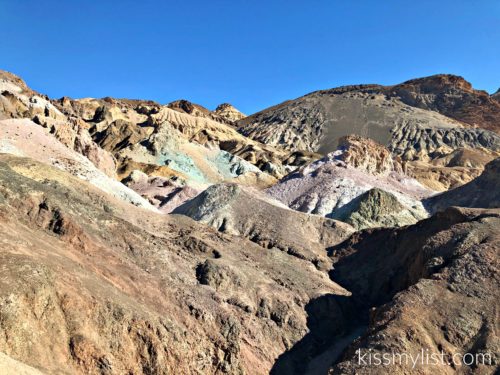
We debate, as our family is apt to do, about the colors of these rocks. The guidebook says periwinkle blue, salmon pink, lemon yellow and sea green. We have differing opinions on the blue and green.
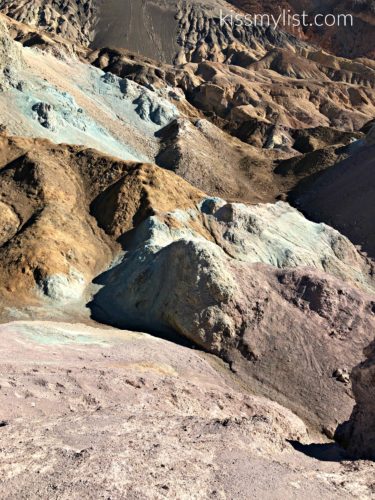
One person in our family sees sky blue where the rest of us see green. You decide, but either way, it’s pretty cool. I climb up and strike a pose.
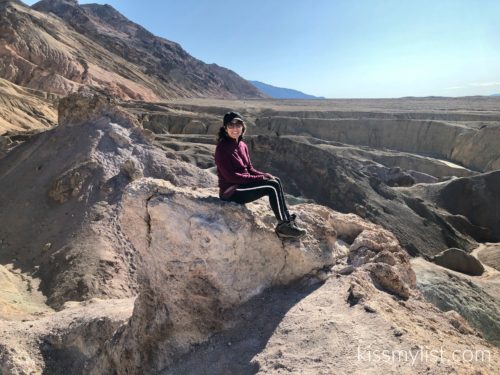
Harmony Borax Works
Our final stop of the day is the remains of this mining operation from the late 1880s. The Harmony plant processed borax ore, using teams of twenty mules attached to wagons like this one to haul the borax 165 miles to Mojave. The plant lasted only five years.
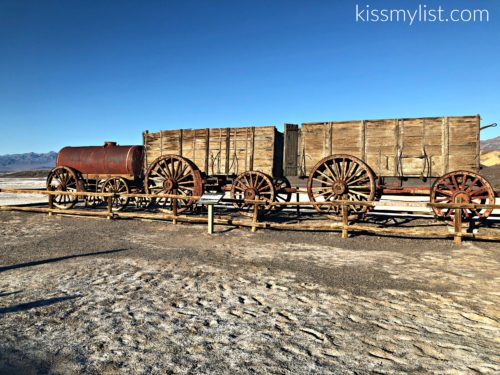
Side note: I am familiar with 20 Mule Team Borax, not because I clean with it, but because I made homemade gak (slime) with it when my kids were in elementary school. I had no idea it was an historically accurate name!
The Oasis at Death Valley
Our hotel is a literal oasis; it’s the only green for miles. We arrive back at our casita via our own personal golf cart, and explore the grounds before the sun sets.
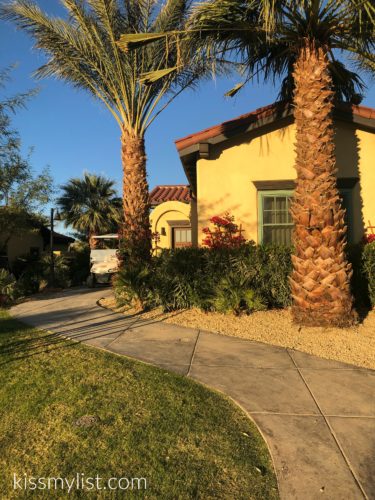
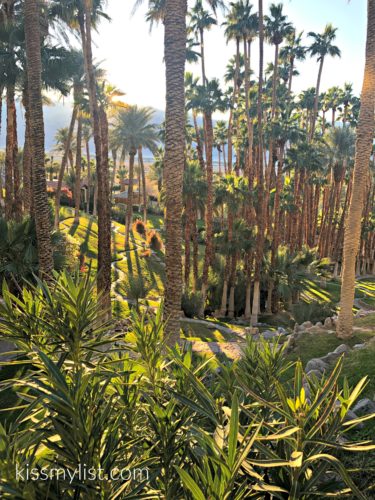
Day Two in Death Valley
Since we saw all the highlights of Death Valley on day one, today we explore a bit farther afield. I did my research and learned that Manzanar was a little over two hours from our hotel in Furnace Creek, but I wasn’t sure how the rest of the family would feel about going. Touring the relocation center where the United States government incarcerated its Japanese citizens during World War II is not a feel-good vacation activity, but it is a piece of our history that is embarrassingly not taught in our schools. I wanted to know, and I wanted my kids to know. So off we drive.
Manzanar National Historic Site
Two hours of windy roads and mountain vistas later, we arrive at Manzanar National Historic Site. We walk into the visitor center and are greeted with this sobering plaque.
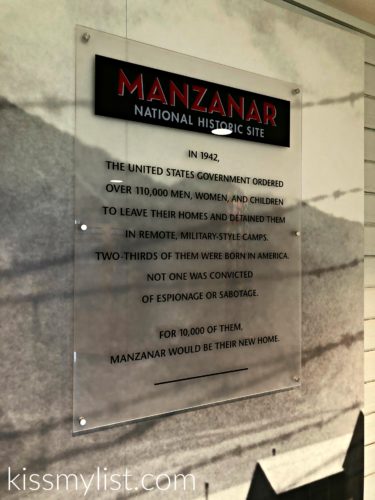
“In 1942, the United States government ordered over 110,000 men, women, and children to leave their homes and detained them in remote, military-style camps. Two-thirds of them were born in America. Not one was convicted of espionage or sabotage. For 10,000 of them, Manzanar would be their new home.”
We spend about forty-five minutes in the visitor center, which is full of information – both historical and personal. The emphasis is “One Camp, Ten Thousand Lives; One Camp, Ten Thousand Stories.” The center is a phenomenal example of making history come alive, and we each wander through the exhibits at our own pace.
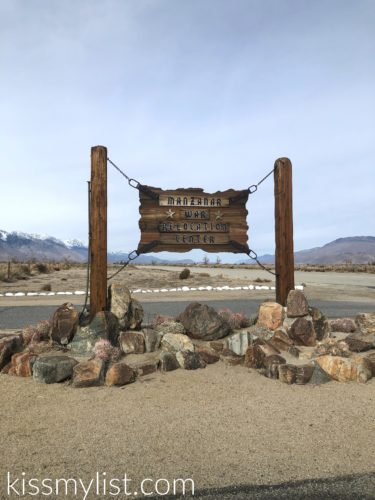
The original sign still adorns the entrance, but not much else remains. We get back in the car to tour the grounds. We pause at the cemetery, which has served as a memorial for the 150 people who died while at Manzanar. All but six were returned to their families after the camp was closed. Today, “visiting the cemetery can be a personal pilgrimage: of reflection, worship, remembrance, or protest.” Source
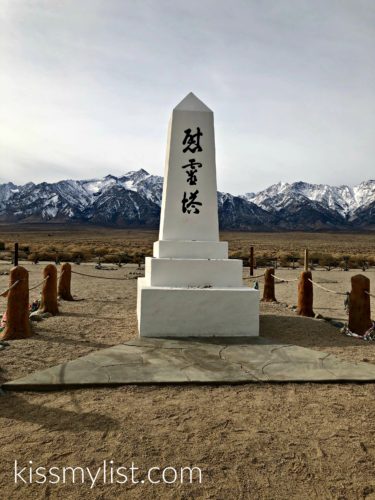
We wind our way through the skeleton of the camp, building sites marked by simple wooden signs. I contemplate the beauty of the majestic Sierra Nevadas as the backdrop to such an ugly chapter in American history.
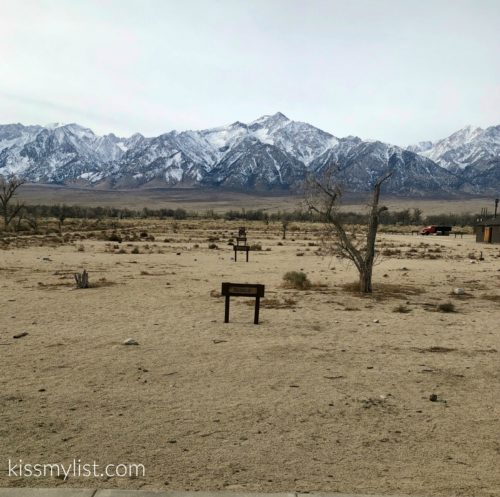
It is a powerful visit, and well worth the drive. As we head back to Death Valley, the scenery is a balm for my anger, and I am grateful we bore witness.
Darwin Falls
Yes, there is a waterfall in Death Valley…it just takes awhile to get there. Using the topographical trail map I purchased at the Furnace Creek Visitor Center (well worth the $15, as my family tends to get lost while hiking), we find the turn off for Darwin Falls. We drive two and a half miles on a dirt road until we reach the trailhead, then hike a mile to find this.
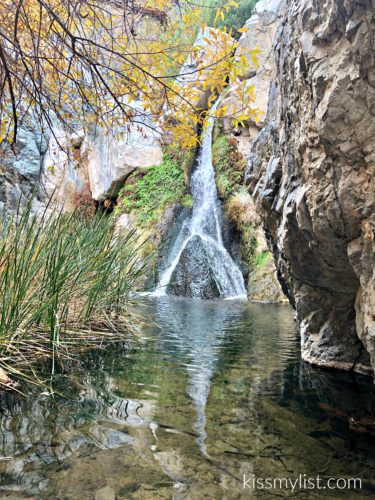
After two days in the desert, this hidden oasis is a gift.
Mesquite Flat Sand Dunes
We return to the brown landscape, but this time it’s sand instead of rock. According to our guidebook, the dunes began as larger pieces of rock from the mountains, eroding to sand size to create these 150-foot dunes.
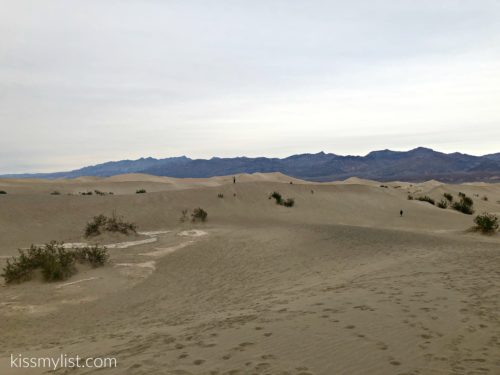
For scale, note that I did not zoom in the photo above, and you can see my son waving, almost dead center. He’s farther away than he looks! We find a lovely couple to take our only non-selfie family photo of the trip.
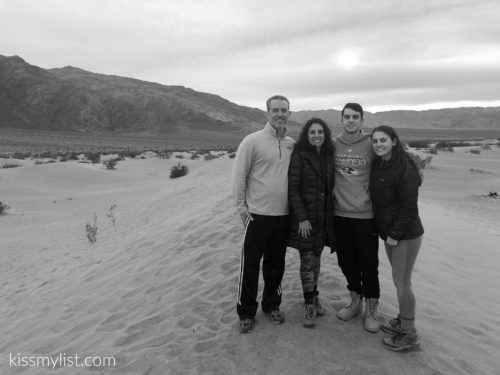
Day 3 in Death Valley
This day was completely open; we could have easily left a day early, but we would have missed some gems that required a few hours on the road.
Mosaic Canyon
This trail is only thirty minutes from our hotel, in the nearby town of Stovepipe Wells.
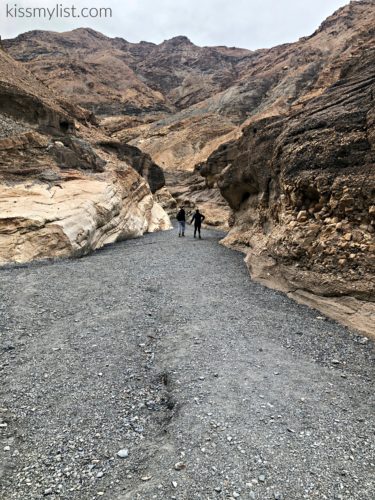
The trail quickly narrows, and we scramble over and under rocks, climbing until we can’t go any higher.
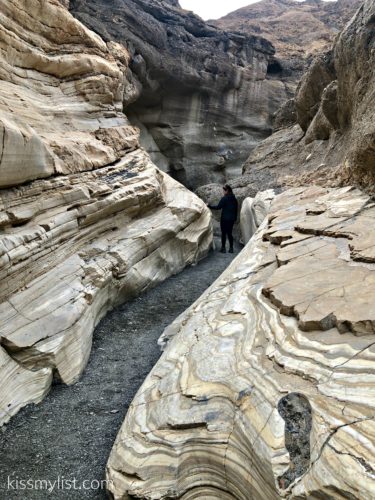
I can’t resist asking my son to pose for a Lion King-esque shot on this huge rock, and I may have sung the song as he presented the backpack Simba to his adoring imaginary pride.
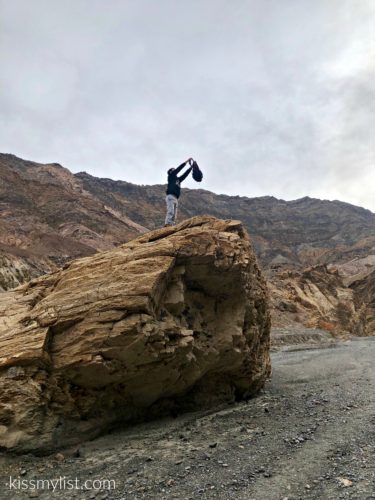
Ubehebe Crater
The kids really want to go here, and while I’m not thrilled about the seventy minute drive, it is completely worth it. Six hundred feet deep and a half mile across, the volcanic crater is awesome.
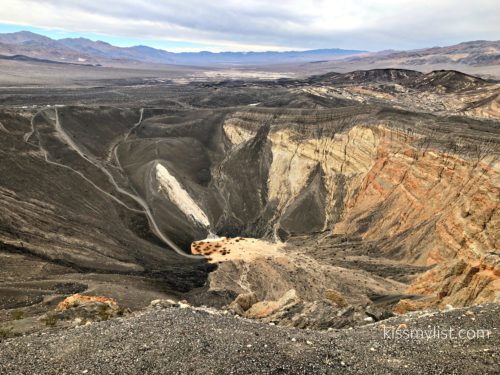
When hot magma rises from underground and reaches water, the heat flashes the water into steam which expands and creates an enormous explosion. Ubehebe is the largest of these resulting craters.
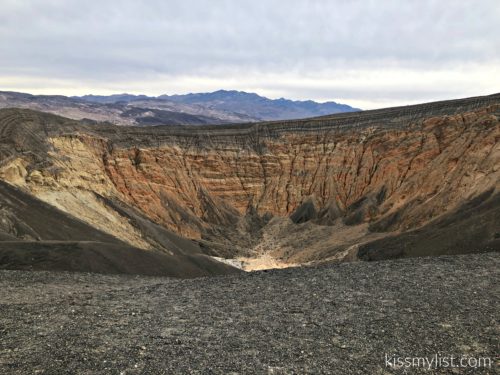
We walk the half mile around the crater, while Matt contemplates hiking down to the bottom. Wiser heads prevail (mine), and we call it a day for hiking.
Rhyolite Ghost Town
Our final stop for the day takes us back into Nevada to visit the largest ghost town near Death Valley. Between 1905 and 1911, Rhyolite was a bustling gold mining town of almost 10,000 people. By 1920, its estimated population was 14.
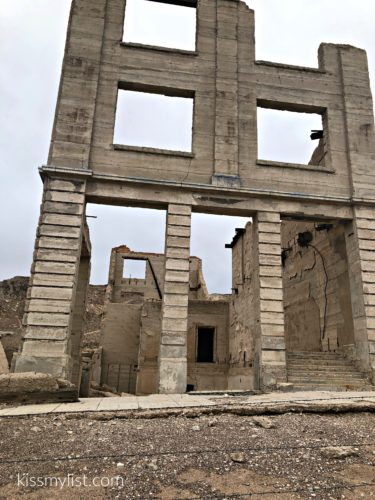
The photo above is of the Cook Bank Building, and below is the remains of the general store.
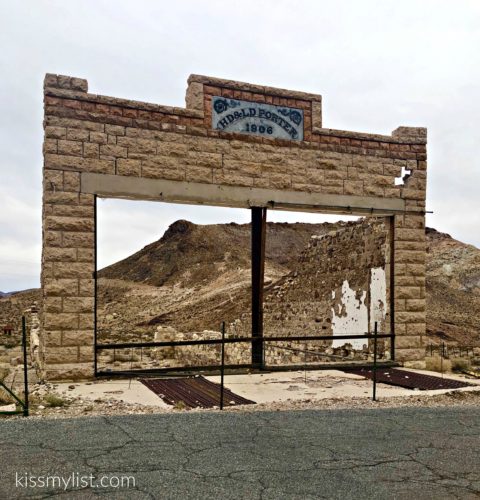
The only building still completely intact is the Bottle House that Tom Kelley built in 1905. He raffled it off, and the winning family lived in it for years. All the navy circles on the exterior are actually the bottoms of glass bottles. It’s quirky and a little creepy.
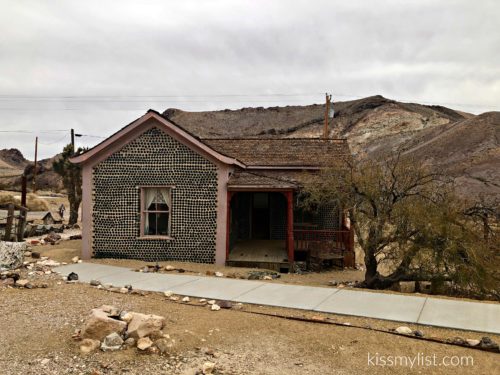
I shake off my heebie jeebies and we head back to Furnace Creek to buy a few souvenirs and snacks for the drive back to Las Vegas. As we leave the general store, we see our last stunning sunset in Death Valley.
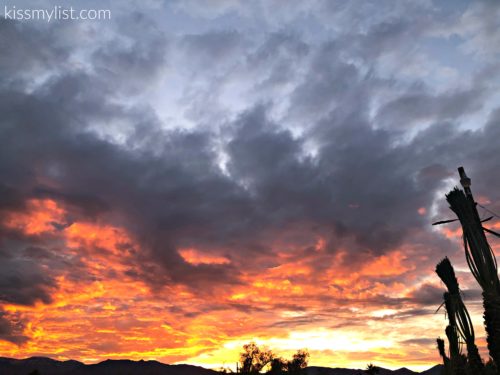
Day four
We say goodbye to California and drive back to Nevada, stopping thirty minutes outside of Las Vegas for our final day of nature.
Red Rock Canyon
Visitors drive through Red Rock Canyon via a thirteen-mile, one-way scenic route. There are twenty-six hikes and trails along the way, and we pull off a few times to take in the views and go on a hike or two.
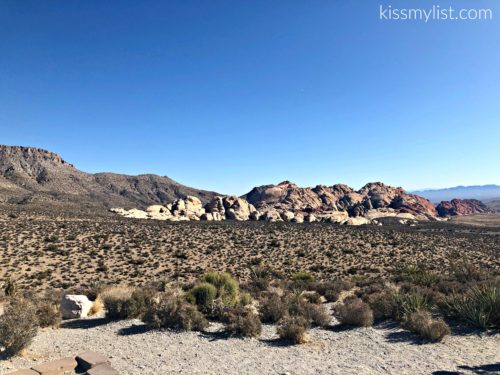
This petroglyph wall is cool; the rock art is estimated to be about 800 years old.
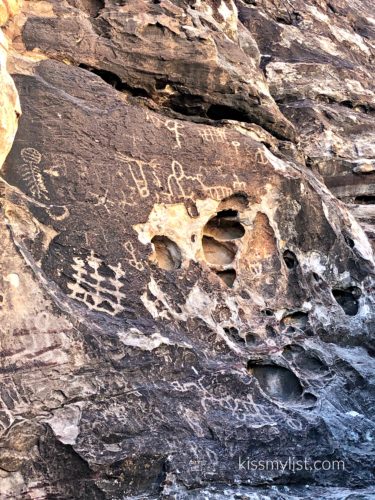
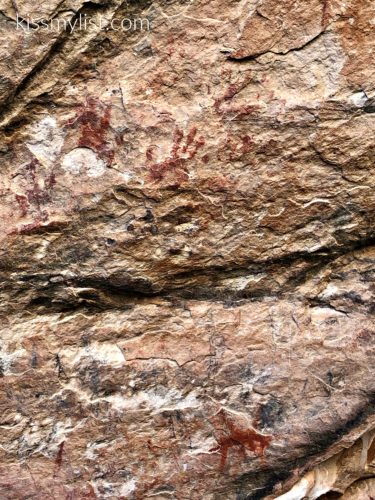
We pull off for one final hike, which frankly I don’t feel like going on. But we do, and we find our second waterfall of the trip. This one is partially frozen.
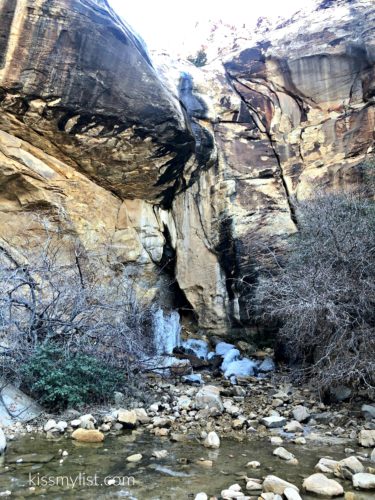
As we are walking back, we hear a coyote yipping. Then we hear another coyote yipping back. We quiet, and the only sounds we hear are two coyote friends having a conversation. They may be saying “hey look at those yummy looking humans,” so we don’t linger.
We arrive in Las Vegas as the sun sets, and head out onto the strip to show the kids the spectacle.
Day five in Vegas, baby!
We spend our final day of vacation wandering in and out of the huge hotels, eating much better food than we had in Death Valley, and schooling our children, ages 18 and 21, on gambling and casinos. The younger one wants to see the lobby of Caesar’s Palace where a scene from The Hangover was filmed. The legal one plays some video poker, and accidentally but happily wins $14. We enjoy the holiday decorations all over town, especially in the Bellagio.
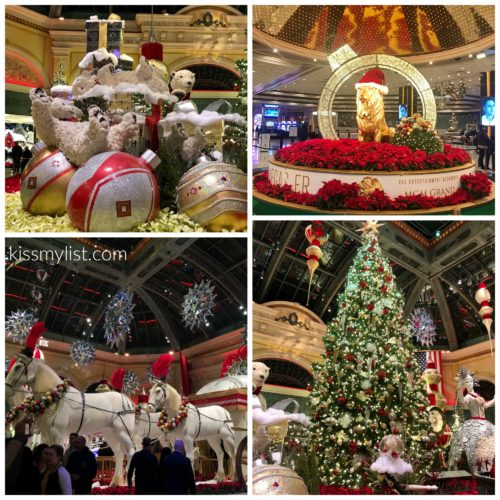
I’ve been wearing sneakers and hiking boots for the past five days, so I drool a bit when I see this shoe:
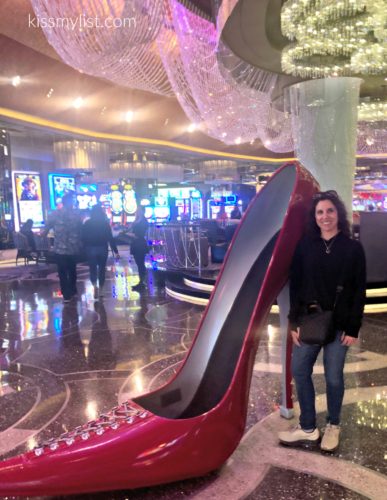
Our vacation was an odd combination of city and nature, of barren desert, concrete and neon. But it was five full days to reconnect as a family, and it made this empty nester’s heart full.

Linking up with Kristi with the prompt “Where are you going?”
You guys had a great time, Dana! Looks like it was a good mix of nature (Death Valley) and glitz (Las Vegas).
Thank you Dana for sharing your trip with us. We were in Arizona last year and some of the scenery seemed similar. We’ve enjoyed our family trips to national parks and need to go on more. Thanks also for sharing the story of Manzanar – I have never heard of it – indeed a very sad commentary on the history lessons I received. If we ever head out to Death Valley, I will revisit this post!
What an amazing trip! I wouldn’t have thought of Death Valley for a destination but now I really want to go. Manzanar sounds vaguely familiar but I’m not sure from where and I certainly didn’t know so many families were held there. I’m glad you were able to spend such great bonding time with both kids home from college. So happy you linked up!
PS they’re building an In N Out Burger really close to where we live and I can’t wait. I bet when it opens the lines will be huge but it’ll be worth it. Come visit – there’s so much amazing landscape and hikes and places to see. Just putting it out there.
Dana, I’m so jealous! On our last road trip, in 2018, we left Yosemite and headed to Vegas, and I wanted to stop in Death Valley, but we ran out of time. And I get not being able to plan family trips. This will be (in April) our first spring break without Hunter. His break is different than the other children. So happy for you that y’all had this time together.
Dana! What a brilliant trip and share. So much packed in those 5 days in culture, beauty, history, and memories. I just read “The Buddha in the Attic” Novel by Julie Otsuka It left me with many questions about the “relocation” of the Americans who were imprisoned, really. And you’re right, although I vaguely knew of this history, it was not from school. I’m glad, too, your family made that part of your trip.
Also love nboth the Lion King photo shoot and that shoe!
Thank you! Now I feel that I have taken this vacation with you. The photos are incredible! I must say that you look like 4 friends and not parents and children!
Aw – you’re too kind! You can certainly see the difference close up;)
I’m jealous that you now know what the In-N-Out Burger fuss is all about. I haven’t been there yet! YET. haha about the backpack Simba. And I never knew there was a waterfall!
It’s never been on my list but if I did go, December would be perfect. I went to Sedona in December and the weather was so amazing. Not hot, but like a dream compared to back home. I felt so much.. safer from dehydration.
We went to Sedona in December too, and I agree – amazing weather. Funny how the temps drop at night in the desert, though – not like our neck of the woods where the temps are pretty consistent from day to night.
I used to live in California, but it never occurred to me to do more than drive through Death Valley. In fact, we only drove through it because there was no way around it for our destination. ha! This was interesting. I had no idea there was so much to see and learn at Death Valley!
Glad I could give you some info, April! Next time you drive through you should make a quick detour – most of the stops we made on day one can be quick and don’t have to involve hiking.
Aw, so glad you finally got to have a family vacation. It looked like the perfect mix of city and nature to me, as well!! 🙂
Thanks Janine!